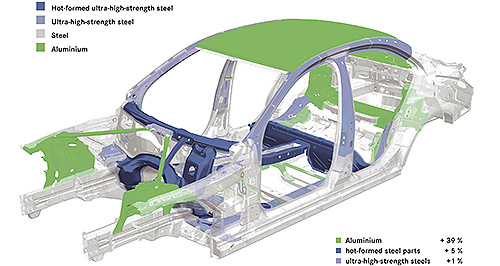Future models - Mercedes-Benz - C-ClassMercedes casts off for new C-ClassMix and match: The new Mercedes-Benz C-Class employs a mix of die-cast aluminium and steel panels of various strengths to achieve benchmark body rigidity and light weight. Aluminium die-cast inner panels help Benz achieve new heights of rigidity23 Oct 2013 MERCEDES-BENZ has revealed that key structural body elements of the upcoming fourth-generation C-Class due next year will be made of die-cast aluminium, contributing to significant weight savings and gains in structural rigidity that helped the company exceed driving dynamics and noise suppression goals for the new version of its global top-seller. The components, such as the sheet-metal body mountings for the front and rear suspension units, are usually stamped from steel in conventional monocoque cars, but in this case were formed in moulds from molten aluminium. Nine large cast components are integrated into the hybrid aluminium-steel body, with aluminium forming 39 per cent of the structure that is also clad with stamped aluminium outer panels such as the fenders, doors, boot lid and bonnet. Five per cent of the structural members are made of hot-formed steel, with a further one per cent made from ultra-high-strength steel. The remaining 55 per cent is fashioned from regular steel sheet stampings. The Stuttgart company used laser welding and bonding glues to stick the whole lot together in a system that it says further contributes to the rigidity of the monocoque. The new C-Class is expected to be launched at the Detroit motor show in January ahead of a global roll-out through 2014, with the first cars for Australia arriving about mid year. Mercedes-Benz this week released cabin interior photographs and some technical details of the new model, along with a teaser video that purports to show glimpses of the new exterior. Several high-end luxury vehicles such as the Audi A8 and new Range Rover employ aluminium construction, but the new C-Class appears to be the first mass-produced sedan to use die-cast aluminium to such an extent in such important body structural areas. Mercedes-Benz said die-cast aluminium provided greater design leeway compared with steel. It says its designers found they could integrate and merge various components in a single die-cast component that would otherwise have to be made up of several steel components with conventional steel designs. “In this way a host of functions can be mapped in a single component and installation space put to optimum use,” it says in media materials released this week. “All shock absorbers are mounted in the front and rear of the vehicle on rigid aluminium diecast components.” The system helped Mercedes cut the weight of the C-Class’s body shell structure by 40kg, while the kerb weight of the whole car has been reduced 100kg, contributing to a 20 per cent fuel consumption cut over the current model. Mercedes says the new body would be not only the light-weight leader in its class but would set new benchmarks for rigidity. “As a result, the ambitious goals regarding driving dynamics and noise levels have been exceeded,” it says. Like the body, major components of the new four-link front axle are fashioned from aluminium, saving two kilograms.  Read moreC-Class pricing
Motor industry news |
Click to shareMercedes-Benz modelsC-Class pricing
Motor industry news |






























Facebook Twitter Instagram